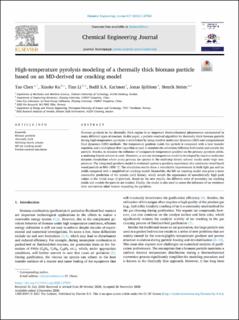| dc.contributor.author | Chen, Tao | |
| dc.contributor.author | Ku, Xiaoke | |
| dc.contributor.author | Li, Tian | |
| dc.contributor.author | Karlsson, Bodil S.A. | |
| dc.contributor.author | Sjöblom, Jonas | |
| dc.contributor.author | Strøm, Henrik | |
| dc.date.accessioned | 2022-03-04T09:52:42Z | |
| dc.date.available | 2022-03-04T09:52:42Z | |
| dc.date.created | 2021-03-17T16:20:51Z | |
| dc.date.issued | 2021 | |
| dc.identifier.citation | Chemical Engineering Journal. 2021, 417 1-16. | en_US |
| dc.identifier.issn | 1385-8947 | |
| dc.identifier.uri | https://hdl.handle.net/11250/2983052 | |
| dc.description.abstract | Biomass pyrolysis in the thermally thick regime is an important thermochemical phenomenon encountered in many different types of reactors. In this paper, a particle-resolved algorithm for thermally thick biomass particle during high-temperature pyrolysis is established by using reactive molecular dynamics (MD) and computational fluid dynamics (CFD) methods. The temperature gradient inside the particle is computed with a heat transfer equation, and a multiphase flow algorithm is used to simulate the advection/diffusion both inside and outside the particle. Besides, to simulate the influence of intraparticle temperature gradient on the primary pyrolysis yields, a multistep kinetic scheme is used. Moreover, a new tar decomposition model is developed by reactive molecular dynamic simulations where every primary tar species in the multistep kinetic scheme cracks under high temperature. The integrated pyrolysis model is evaluated against a pyrolysis experiment of a centimeter-sized beech wood particle at 800–1050 °C. The simulation results show a remarkable improvement in both light gas and tar yields compared with a simplified tar cracking model. Meanwhile, the MD tar cracking model also gives a more reasonable prediction of the species yield history, which avoids the appearance of unrealistically high peak values at the initial stage of pyrolysis. Based on the new results, the different roles of secondary tar cracking inside and outside the particle are studied. Finally, the model is also used to assess the influence of tar residence time and several other factors impacting the pyrolysis. | en_US |
| dc.language.iso | eng | en_US |
| dc.publisher | Elsevier | en_US |
| dc.rights | Navngivelse 4.0 Internasjonal | * |
| dc.rights.uri | http://creativecommons.org/licenses/by/4.0/deed.no | * |
| dc.title | High-temperature pyrolysis modeling of a thermally thick biomass particle based on an MD-derived tar cracking model | en_US |
| dc.type | Peer reviewed | en_US |
| dc.type | Journal article | en_US |
| dc.description.version | publishedVersion | en_US |
| dc.source.pagenumber | 1-16 | en_US |
| dc.source.volume | 417 | en_US |
| dc.source.journal | Chemical Engineering Journal | en_US |
| dc.identifier.doi | 10.1016/j.cej.2020.127923 | |
| dc.identifier.cristin | 1898795 | |
| dc.relation.project | Norges forskningsråd: 267916 | en_US |
| cristin.ispublished | true | |
| cristin.fulltext | original | |
| cristin.qualitycode | 2 | |

